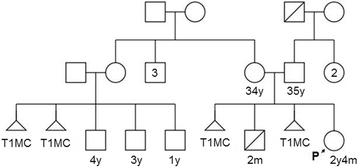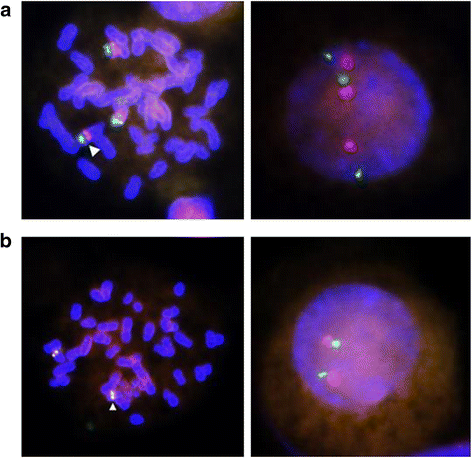A child with multiple congenital anomalies due to partial trisomy 7q22.1 → qter resulting from a maternally inherited balanced translocation: a case report and review of literature
- PMID: 29739404
- PMCID: PMC5941489
- DOI: 10.1186/s12920-018-0366-6
A child with multiple congenital anomalies due to partial trisomy 7q22.1 → qter resulting from a maternally inherited balanced translocation: a case report and review of literature
Abstract
Background: Parental balanced reciprocal translocations can result in partial aneuploidies in the offspring due to unbalanced meiotic segregation during gametogenesis. Herein, we report the phenotypic and molecular cytogenetic characterization of a 2 years and 4 months old female child with partial trisomy 7q22 → qter. This is the first such reported case resulting from a parental balanced translocation involving the long arms of chromosomes 7 and 14. The phenotype of the proband was compared with that of previously reported cases of trisomy 7q21 → qter or 7q22 → qter resulting from parental balanced translocations.
Case presentation: The proband was born pre-term to a 34-year-old mother with a history of two first trimester miscarriages and an early infant death. She was referred at the age of 8 months for genetic evaluation due to prenatal and postnatal growth retardation, developmental delay and multiple congenital anomalies. On clinical evaluation, she had craniofacial dysmorphic features such as scaphocephaly, large anterior fontanelle with open posterior fontanelle, prominent occiput, triangular face, high forehead, hypertelorism, down slanting eyes, flat nasal bridge, small nose, low set ears, micro-retrognathia, high arched palate and short neck. Cranial computerized tomography scan showed lateral ventriculomegaly with features of early cerebral atrophy. Conventional cytogenetic analysis showed the karyotype 46,XX,der(14)t(7;14)(q22;q32)mat in the proband due to an unbalanced segregation of a maternal balanced translocation t(7;14)(q22;q32). Fluorescence in-situ hybridization analysis confirmed the partial trisomy 7q22 → qter in the proband with a minimal loss of genetic material on chromosome 14. Single nucleotide polymorphism array further confirmed the duplication on chromosome 7q22.1 → qter and a small terminal deletion on chromosome 14q32.3 → qter.
Conclusion: We report the longest-surviving child with trisomy 7q22 → qter due to a parental balanced translocation between chromosomes 7 and 14. Clinical features observed in the proband were consistent with the consensus phenotype of partial trisomy 7q22 → qter reported in the scientific literature. Early diagnosis of these patients using molecular cytogenetic techniques is important for establishing the precise diagnosis and for making decisions pertaining to the prognostication and management of affected individuals.
Keywords: Congenital malformations; Fluorescence in-situ hybridization; SNP array; Translocation (7;14); Trisomy 7q.
Conflict of interest statement
Ethics approval and consent to participate
Written informed consent was obtained from the parents for the clinical assessment and testing on a consent form approved by the Ethics review Committee, Faculty of Medicine, University of Colombo.
Consent for publication
Written informed consent was obtained from the parents for the publication of all personal information contained in this case report and accompanying images.
Competing interests
The authors declare that they have no competing interests.
Publisher’s Note
Springer Nature remains neutral with regard to jurisdictional claims in published maps and institutional affiliations.
Figures





References
-
- Ponnala R, Dalal A. Partial monosomy 7q. Indian Pediatr. 2011;48:399–401. - PubMed
-
- Xiao B, Ji X, Jiang WT, Zhang JM, Hu Q, Tao J. A case with partial trisomy 7 (q34→ qter) derived from a paternal reciprocal translocation t(7; 14)(q34; q32) [abstract] Zhonghua yi xue yi chuan xue za zhi= Zhonghua yixue yichuanxue zazhi= Chinese J Med Genet. 2011;28:654–657. - PubMed
Publication types
MeSH terms
LinkOut - more resources
Full Text Sources
Other Literature Sources

